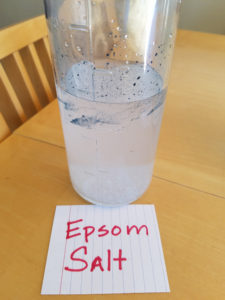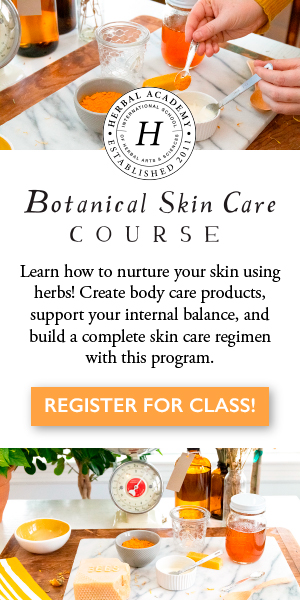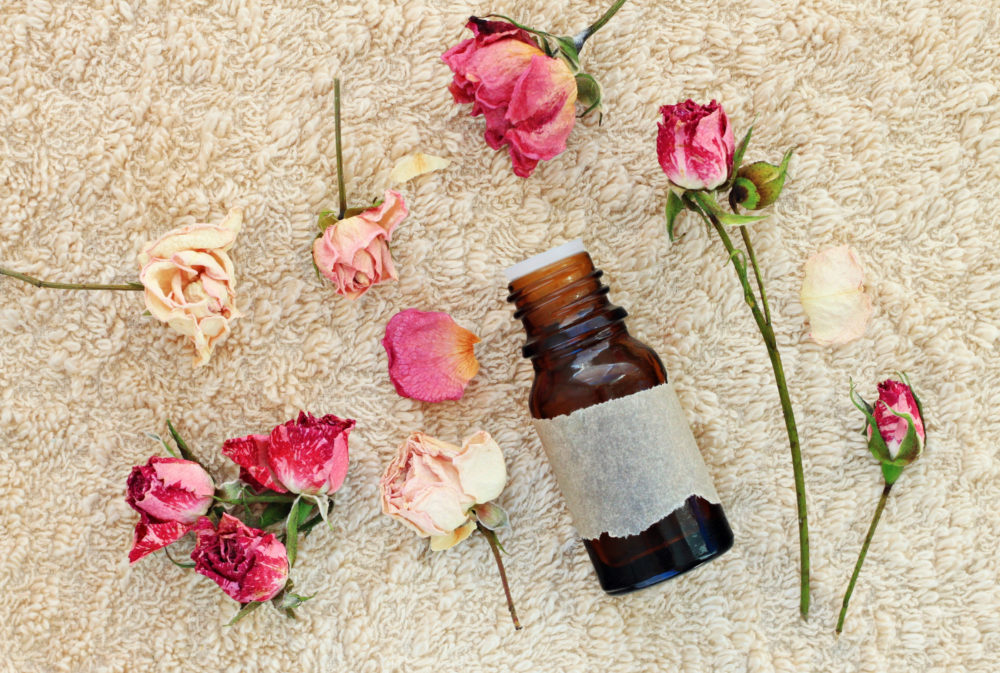
by Leslie Moldenauer | | Essential Oils
Aromatherapy, not “always or ever”, not “black and white”. What do I mean by that? A quick visit to social media can leave a home user dizzy with information, much of it is erroneous; hearing statements like never use on babies, never take internally, and always dilute are commonplace.
I understand that some professionals are making attempts to keep the home user safe, as well as keeping children from being exposed to neat oils at a very early age among other things. Let me assure you, I share that concern, as they are valid. However, the fear that is being instilled in statements like “Oh my, you should never do that”, is not helping anyone.
To be fair, it can be a difficult task to find quality, reliable information on the Internet surrounding the art and use of aromatherapy. I have taken to speaking about safety often for this very reason. I have extended knowledge in my field, and to some, my education may not have even scratched the surface.
There is one that I am sure of, that the professionals in the field of aromatherapy have a few things in common:
- We want to help you. We decided to go into the field of aromatherapy as we are healers in our own right. This is our passion, and our mission statements may vary, but have one common thread: “First do no harm”.
- Learning is ongoing. We do not have all the answers but are always seeking them. We all want to be experts in our craft.
- We all believe in the magic and powers of essential oils, and have seen firsthand how they can help in a variety of situations.
Now our approach may not all be the same. And even more importantly, our education is not all the same: different institutions, different amount of hours, a different focus or niche among other things. This can be problematic. Therefore, it is important for you, the end user, to do your own research. At the very least ask the aromatherapist what their credentials are, and ask for resources to back up what they are telling you. When my clients ask for these things, I am more than happy to oblige. I would expect you to do the same thing if it were a pediatrician or psychologist. Every single one of us in every aspect of our lives is “practicing”, whether we are a professional, a parent, or a friend. A good rule of thumb is utilizing what works and discarding what doesn’t.
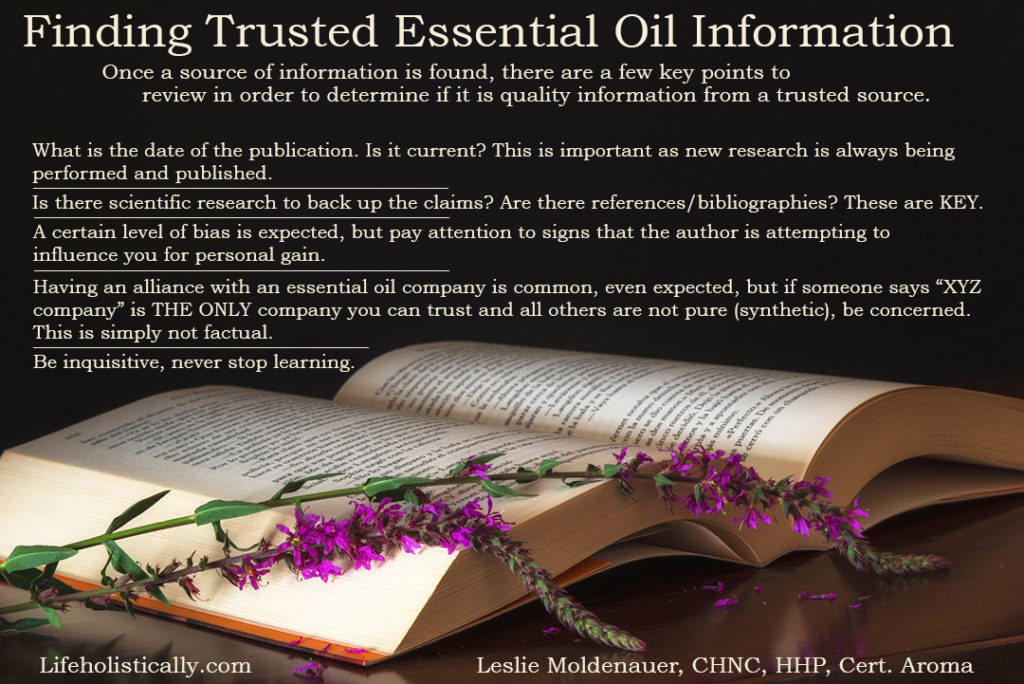
Never Examples
My first example of a “never” statement is telling others to NEVER take oils internally. This is not helping anyone. What should be discussed is how to do so safely and when does it make sense to do so. For the record, it is not in water, or neat under your tongue. Follow this link for more.
Another example is NEVER using essential oils on babies. This is not looking at the big picture. Some will tell you no oils before two years of age, some say no oils before five years of age, some say no oils before 10. Based on scientific research (key term here) this is what we do know:
**Oils should typically be avoided topically for infants and small babies under a few months of age. The reason for this is their integumentary system (skin) does not mature until then and using oils topically (even when diluted) can increase the risk for adverse reactions and set them up for possible sensitization.
**There is a pretty extensive list of oils that should not be used “dermally” under two years of age. This does not imply the statement above of “no oils under two”.
(Please reference Robert Tisserand’s Essential Oil Safety 2e for the details)
**Babies and children ARE much less equipped to handle certain essential oils topically, due to immature livers and detoxification systems. Less is more, the gentle way first utilizing herbs and hydrosols, are things that I agree with. This is the reason why many recommend speaking to a professional. It should not be to induce fear, but to empower you to know the right way, period.
**Last example in regards to children: NEVER use eucalyptus essential oil under the age of 10. This is a fear based statement and not all that accurate, BUT there are precautions to know about and be cognizant of. According to Robert Tisserand, this oil (high in 1,8 cineole) should be kept away from the face for children under 10 years of age, especially for those children that are susceptible to issues such as seizures or have other CNS weaknesses. This does not mean NEVER, it means you need to know what you are doing (Source)
Always Example
ALWAYS dilute. On social media, this may be the best way to keep the general population safe as SO MANY are recommending neat use. It is not an always statement. All aromatherapy professionals know that there can be a time and place for undiluted oils. A better statement would be: It is very important to know when and where to apply oils undiluted and to know which oils carry a high risk of irritation/sensitization. If you do not know how to safely navigate this for yourself, you are better off diluting everything you apply topically. This is especially the case for children. Please do not take this kind of advice from someone that is not educated. Sensitization is real, it does happen, and it is ugly.
In Conclusion
Aromatherapy is simply not black and white, and nothing is always or never. Safety should always be the first consideration, and everyone has his or her different way of handling it. If you can do one important thing here for yourself, it is to do your due diligence and find out the facts, with CREDIBLE resources. While essential oils should not be feared they should be respected, researched, and used properly to ensure the safety of the individuals using them.
Like so many practices in life I encourage you to become educated on the proper use of essential oils. When using them, please do so cautiously, understanding that there is often misinformation on the Internet. You can be assured that I support only educated and proven resources. While essential oils should not be feared they should be respected and used properly to ensure the safety of the individuals using them. Please note that I am not a medical practitioner. The content of the website is provided for general informational purposes only and is not intended as, nor should is be considered a substitute for, professional medical advice. Do not use the information on this website for diagnosing or treating any medical health condition. If you have, or suspect you have a medical problem, promptly contact your professional healthcare provider. By using this website, you assume full responsibility and liability for your own actions.
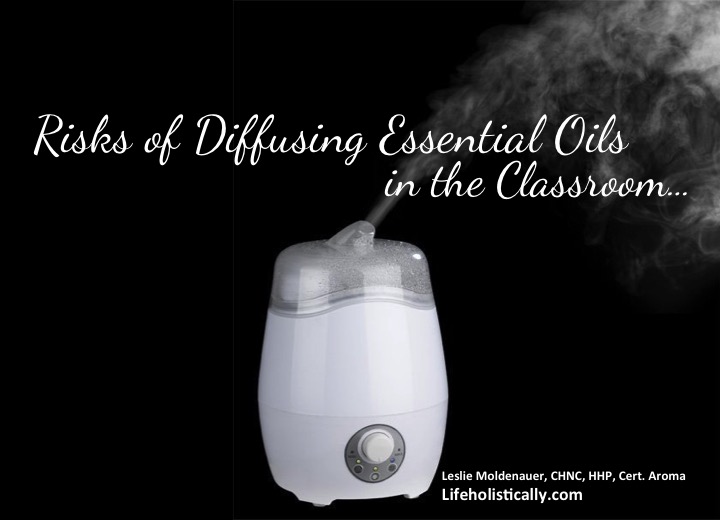
by Leslie Moldenauer | | Essential Oils
The risks of diffusing essential oils in the classroom. If we take into consideration the number of germs that are passed back and forth at school, it is not a surprise that some teachers have considered diffusing essential oils in the classroom. For those with minimal education, this may seem like a great solution to keeping sickness at bay and to keep attendance up, but it comes with a significant amount of risk. Many are told that essential oils are completely natural and safe for everyone, but this is not always the case. There are many things that need to be considered when diffusing in a classroom full of children with a variety of different health constitutions. The liability in this type of situation needs to be looked at closely.
First things first, I know many teachers personally and have had the pleasure of having some wonderful teachers for my two boys over the years. I can say without a doubt, that they hold your child’s well-being very close to their heart. They would not want to do anything to harm a child.
I hope to clear up the variety of possible issues of the practice of diffusing in the classroom so that parents, teachers, and faculty can understand the safety issues and the risks. I hope to assist them and you so that everyone can make informed decisions for the well being of our children.
Essential Oil Home Use
Essential oils are a beautiful complementary modality. They come from plants but even though they have the potential to assist the body in doing what it does best, they do not come without risk. The home user can utilize essential oils after a little bit of research. The “basics” of aromatherapy can be researched on the Internet. The more in-depth topics, however, need more scientific, evidence-based research.
When looking on the Internet for research, many times the method of application and safety is not covered, so in cases of someone searching for information with limited knowledge of the topic, it can be a precarious situation. The recommendations given online come from a place of wanting to help others, but many times, they miss the mark.
Essential Oil Classroom Use-The Risks
One of the many reasons for more scientific research of essential oils is they do not come without risk, especially for children. A classroom has an average of 20 children. Some of which may be immune-compromised, taking numerous medications, have allergies, chemical sensitivities, respiratory issues such as asthma, an increased risk of seizures, autoimmune diseases and more. A teacher could not possibly know how one seemingly innocuous essential oil could react among those 20 children. The reactions for just one child could change from day to day as well. Aromatherapists know when working with clients what works for one person may not work for another. It may be offensive or have the completely opposite reaction/effect.
Asthma
There are numerous oils that should not be used with children who have asthma. Asthma and essential oils are very tricky. The triggers for one person are completely different to the next. Even seasoned aromatherapists recommend extreme caution when trying essential oils for clients with asthma. I myself, insist that an asthma sufferer have their inhaler handy when trying a particular oil or oil blend for the first time as well as the 3rd, 10th, and 50th time. Asthma can be a life-threatening situation, and many oils, as well as other aromas in the environment, can trigger it.
ADD, ADHD, Autism
Another health situation that needs great consideration is ADD, ADHD, and autism. A great example here is the essential oil of Lavender Lavandula angustifolia. It is a known phenomenon by aromatherapists that many with ADHD have a manic type reaction to lavender rather than what should be a sedating one. Here is an informative article that was written by educator Sylla Sheppard-Hanger of the Atlantic Institute of Aromatherapy that covers the topic in more detail.
Chemical Sensitivities
Chemical sensitivities are becoming more and more common in society. The initial cause is not fully understood, but various chemicals in the environment can be a trigger it. Many chemical components in essential oils are also found in the environment. Let’s look at Limonene as an example. Limonene is found in many of the citrus essential oils and is also found in the environment in degreaser, Goo-Gone, wood finisher, and other items that can be found in the household. Many foods contain minimal amounts of essential oil constituents. Some may be surprised to know that cinnamaldehyde found in cinnamon and cassia oils (think popular anti-germ blends) is found not only in household cleaning products and candles, but is also in cinnamon bread, cereals, cookies, puddings, applesauce, and fruit juices in the supermarket (1).
Essential oil constituents cross over into common household products, home goods, and foods in many more instances than these. For those that have chemical sensitivities, the day to day can be very challenging. Some of the possible symptoms of chemical sensitivity are headaches, nausea, dizziness, rashes, respiratory difficulty (including asthmatic episodes), and cognitive dysfunction (2). The more immune-compromised a person is, the more likely they are to have these sensitivities.
Unfortunately, there are many other chemicals in the classroom that can be an issue as well. Limiting exposure to the toxic chemicals of conventional household cleaning products can be done. Using essential oils for cleaning hard surfaces is a great idea, ONLY in the evening after the children have gone home for the day. Here is a great resource for you from the Aromatic Wisdom Institute, to help you to clean with essential oils safely.
Seizures
There are a few oils that are not recommended around children (or adults) that have a seizure disorder or a predisposition to them. Essential oils with high amounts of camphor are a known issue, those include but are not limited to: Ho leaf CT camphor, Spanish lavender, wormwood, sage, basil, spike lavender, rosemary CT camphor (camphor is not the only constituent that has the potential to precipitate a seizure). Various species of eucalyptus, although not common, has the potential to precipitate a seizure when used near the face of a child under 10 years of age (3).
These situations are rare but have happened in children, so it is important to understand the risk.
Liability
Now that I have covered a few of the various health issues that could make diffusing essential oils in the classroom risky, let’s briefly cover the liability of doing so. Parental consent for every child is a must. Those parents must be told which oils will be diffused, and what those risks are for certain children. (As you can see by what I covered above that is not going to be easy). Essentially, school boards must be the ones to come up with guidelines and policies for such a practice.
If parental consent is not obtained before classroom diffusing and something happens to a child, the liability is great for the teacher and the school district. Sadly, there are some instances, (speaking from experience) where the principal of a school may not even be aware of the practices of the teacher. In this particular instance, the teacher thought that she was doing something that would benefit the children. The school district already had a rule in place stating there are no diffusing essential oils in the room with children present so it was handled quickly.
Diffusing Times
Even though we now know that diffusing in the classroom is not the best practice for everyone’s safety, I want to briefly cover safe diffusing. Robert Tisserand states that 30-60 minutes of diffusion followed by a 60-minute break is best (4). (I typically recommend half this amount of time for a child). Extended diffusing can overwhelm the senses.
In order to explain the possible reasons for this, let’s talk a little bit about our sense of smell, or our olfactory system. According to Dorene Petersen of ACHS, “Our sense of smell goes through five stages, those are: detect, transmit, perceive, analyze, and store. These stages cycle incredibly fast. The reception area of our olfactory system is called the olfactory epithelium. The olfactory epithelium is the size of a small postage stamp in each nostril and is packed with an impressive 40 million sensory neurons, capable of detecting .0000000013 of an ounce of a scent in a single breath of air” (5). Our olfactory system is incredibly efficient, obtaining the therapeutic benefits of these amazing oils happens quickly. To receive maximum benefit and not waste your precious oils, follow the diffusing times recommended above.
Another important myth to dispel is that diffusing essential oils rids the air of the VOC’s present. This is not factual. The most effective methods in counteracting VOC’s in the home is a high-quality air filter, houseplants, and making sure you allow the fresh air in as much as possible.
A Possible Alternative
A personal inhaler is an option for a child to take to school (with permission). They can be helpful for a variety of reasons such as allergies, stuffy nose, or to help with anxiety or improve focus. The personal inhaler’s scent is limited to the user, meaning no other children become exposed to the scent or the vapor. As long as the parent is sure of the safety of their child and they understand they are not to share it, the risk is removed for the teacher, faculty, or the other children in the room.
In Conclusion
As you can see, essential oil use must be evaluated for each individual, circumstance, and the environment. These are general guidelines that do not mean definitive results in all cases. This article was not written to instill fear, but to respect their uses and limitations.

References:
(1) Cinnamaldehyde content in foods determined by gas chromatography-mass spectrometry
(2) Multiple Chemical Sensitivity. Retrieved from
http://www.webmd.com/allergies/multiple-chemical-sensitivity#1
(3) (4) Tisserand, R., Young, R. (2014) Essential Oil Safety (2nd Ed)
(5) Petersen, D. (2012) Aroma 101
Resources from above and more!
Extreme Chemical Sensitivity Makes Sufferers Allergic to Life
Green Cleaning with Essential Oils
Lavender: It’s not always calming
Personal Inhaler
Like so many practices in life I encourage you to become educated on the proper use of essential oils. When using them, please do so cautiously, understanding that there is often misinformation on the Internet. You can be assured that I support only educated and proven resources. While essential oils should not be feared they should be respected and used properly to ensure the safety of the individuals using them. Please note that I am not a medical practitioner. The content of the website is provided for general informational purposes only and is not intended as, nor should is be considered a substitute for, professional medical advice. Do not use the information on this website for diagnosing or treating any medical health condition. If you have, or suspect you have a medical problem, promptly contact your professional healthcare provider. By using this website, you assume full responsibility and liability for your own actions.
BEFORE YOU GO! Remember to sign up for my FREE Facebook group! Hang out with me and THOUSANDS of other Essential Oil lovers looking to learn, click on to join Real Essential Oil Education Group!
Check out my FREE offer below!
Essential Oils-Uncovering Fact From Fiction
Safety surrounding diffusing essential oils

by Leslie Moldenauer | | Essential Oils
With so much mis-information on the Internet, where do you turn for accurate advice? I give references when possible to do your own research. Even when you get information from someone you trust, you need to do your own homework before utilizing essential oils. My references are not typically random blog posts or anything that has not been fully researched, but books from pioneers in the field of aromatherapy, their articles, journal articles, or studies, etc.
This article will be speaking to aromatherapy use during pregnancy and beyond into the nursing years. I decided to write about this because there are a lot of misconceptions out there. Pregnancy is a delicate time, especially during the first trimester, and as we know that chemical constituents in essential oils pass the placenta, even though only in minute amounts, so safety needs to be addressed.
According to International Federation of Professional Aromatherapists (IFPA), “Essential oils by their very nature, being organic substances, will cross the placental barrier and have the potential to affect the fetus. However, the amount of essential oil that actually accesses the mother’s skin is very tiny and therefore the amount that reaches the placenta is minuscule if proper dilutions are being used. Small amounts of essential oils can be beneficial to the baby and there are no recorded instances of harm being caused to the child through essential oils used in aromatherapy massage” (1).
On the flip side of the coin, aromatherapy is rarely, if ever, black and white. It is not a NEVER or ALWAYS modality. Jane Buckle, PhD, RN, has been using essential oils successfully in a clinical setting for years. Essential oils can have many beneficial properties relevant to pregnancy, labor, delivery, and postpartum (2). The key is knowing which oils to use, and how to use them. They are very useful for stress, nausea, pain, comfort, and even prove to be quite beneficial in labor and delivery.
The use of aromatherapy can also be extremely beneficial to those afflicted with postpartum depression. Essential oils are a wonderful complementary modality, but a specific oil or oil blend that works for one person, may not work for another. Therefore, I try to stay away from “recipe” recommendations online. This is not beneficial to the individual.
I performed an interview recently with Pam Conrad, PGd, BSN, RN, CCAP. Pam earned her Bachelor of Science Nursing degree from Purdue University and has been a registered nurse for over 25 years. Pam completed R J Buckle and Associates 18-month Clinical Aromatherapy course for healthcare professionals in 2000. The interview focuses on labor, delivery, and postpartum. Pam does mention in the interview about benefit vs risk. As I feel it is important to see all possible sides of the equation, I am posting the link to the full article here.
We are all unique…what works for me may not work for you!
Marguerite Maury, a pioneer of aromatherapy stated, “To reach the individual we need and individual remedy. Each of us is a unique message. It is only the unique remedy that will suffice”.
It has been noted by some that peppermint and spearmint are not safe during pregnancy. They can in fact be used safely for nausea during pregnancy as well as postpartum. Placing a couple of drops in an inhaler can be very helpful. Some mother’s report a decrease in breast milk production with the mint families, others do not. The evidence is anecdotal. Use sparingly and as stated below, until you know how or if they work for you. Never take internally.
The do not use list in Robert Tisserand’s Essential Oil Safety 2e in regards to pregnancy does not account for medical conditions or medications. In these situations, additional research needs to be done before using essential oils, as your list of “do not use” may be more detailed. Please seek out an aromatherapist for assistance.
Essential oils are complex, training is recommended…
There are a few recommendations that are important to follow during pregnancy such as:
- Unless under the care of a trained professional, essential oils should not be used internally. (more…)
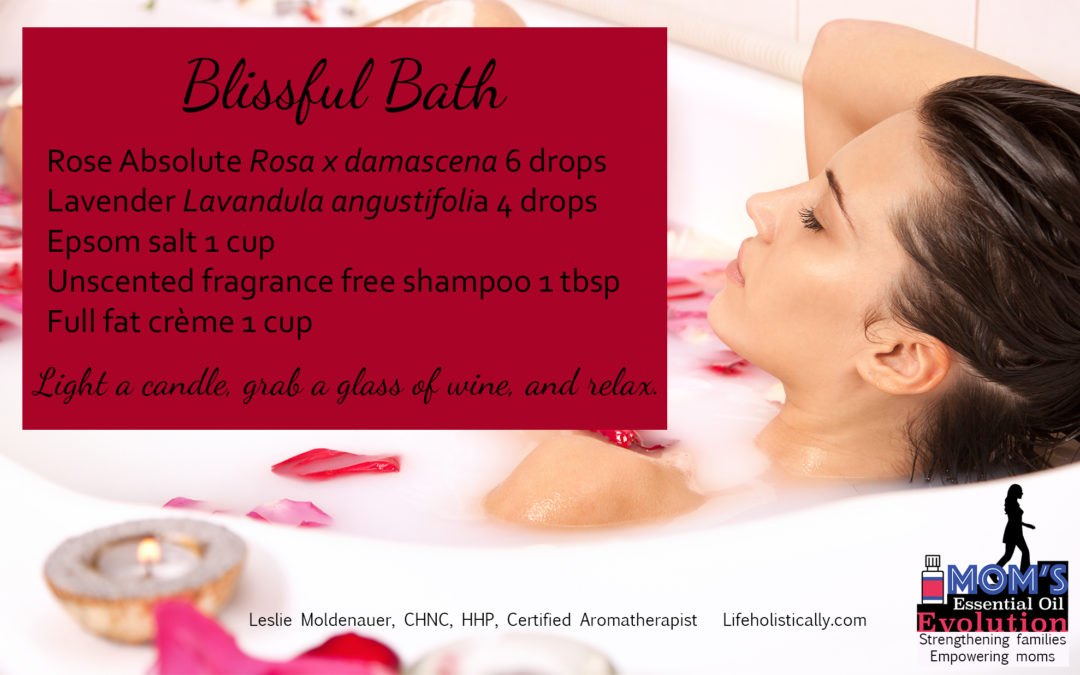
by Leslie Moldenauer | | Essential Oils
Proper use of essential oils in the bath. Not only are the specific oils used in the bath of great importance, safety needs to be considered in how you add them as well. For example, use peppermint with great caution as it can be a very “eye-opening” experience, and bergamot is a very strong photosensitizing oil, the bath is simply not the “best” place for its use.
There are many bloggers that recommend adding essential oils to (only) Epsom salts for a calming bath experience. This is not recommended. In order to cover why that is, let’s talk just a moment about chemistry.
Essential oils are not soluble in water. Essential oils are lipophilic (fat-loving), also called non-polar substances (but they are not actually fats). In contrast, Epsom salts or sea salt hydrophilic (water-loving), also called a polar substance. As a general rule, polar substances will dissolve in polar solvents and non-polar substances will dissolve in non-polar solvents. This confirms the fact that water and oil do not mix.
One option is adding your essential oil to carrier oil before stepping in. This is an option, and it does avoid neat application on the skin (never recommended). So if you are in a pinch you can use a carrier oil.
Alas, there is a better way!
A surfactant is used to properly disperse essential oils in the bath. A surfactant is something that will cause two substances that do not easily mix together (oil and water), to chemically bond and remain mixed. A surfactant’s job is “connecting” the two together.
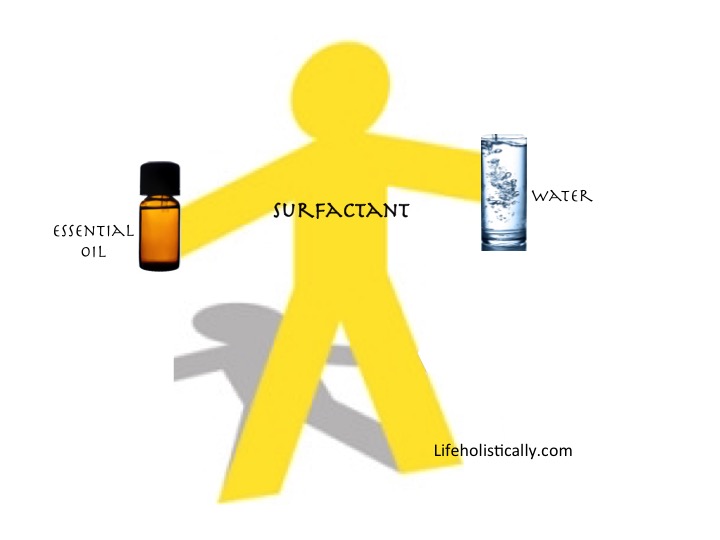
Soap, for example, has a chemical structure that is attracted to water on one end and attracted to oil on the other. Castile soap, shampoo, or bubble bath is very effective. Another option is a product called Solubol, it can work beautifully to mix oil and water, but I prefer to use fragrance-free shampoo.
I performed an experiment recently to show how essential oils dissolve in water and varying substances. Let’s take a look!
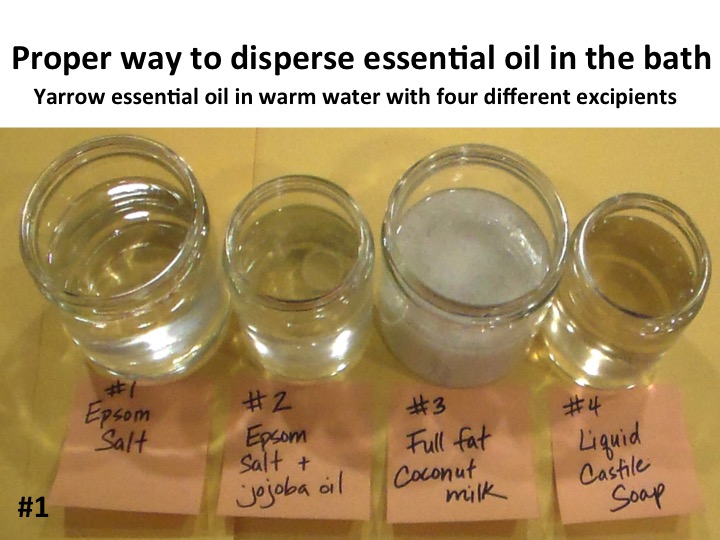
I used yarrow essential oil for its blue color. I used very warm water in all 4 containers. I thoroughly mixed the containers, multiple times, and let them settle.
My mixes are as indicated in image #1 are:
#1-Epsom salts (2 tbsp) 4 drops eo
#2-Epsom salts (2 tbsp) and jojoba oil (1 tbsp) 4 drops eo
#3-Full fat coconut milk (2 tbsp) 4 drops eo
#4-Liquid castile soap (2 tbsp) 4 drops eo
The results?
#1 was the worst of the 4. All of the oil sat on the very top of the water.
#2 the essential oil and carrier oil mixed together well, to then sit on the top of the water. (Better than #1 or neat use, but still not the best).
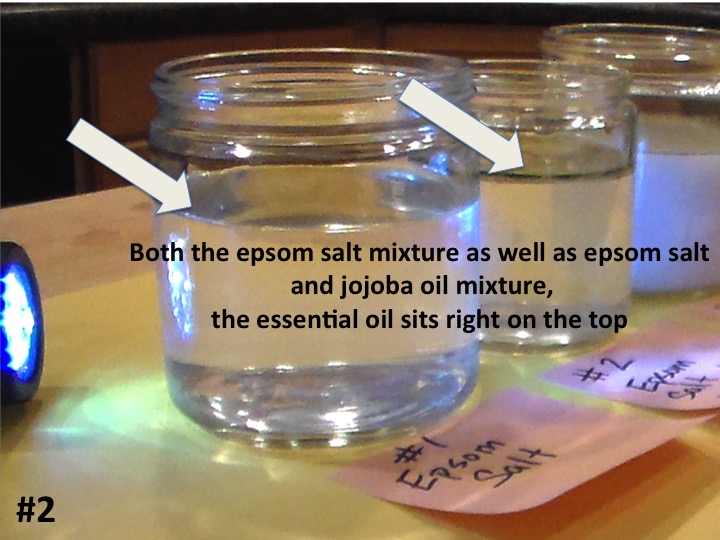
#3 was average at best. The image is not perfect because you can not see through the glass, but there are small droplets throughout the container, with many large droplets still sitting on the top. (Check the top of this container in image #1, you can see the droplets.
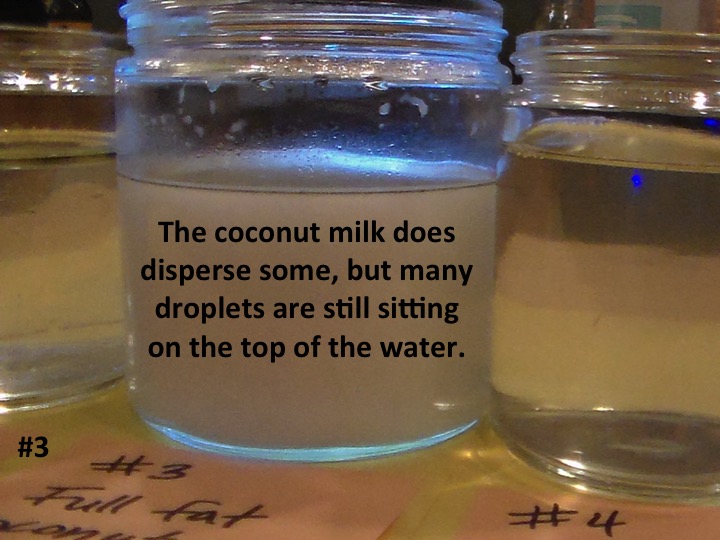
#4 and winner, liquid castile soap. It mixed rather well, no droplets on top, or within the container.
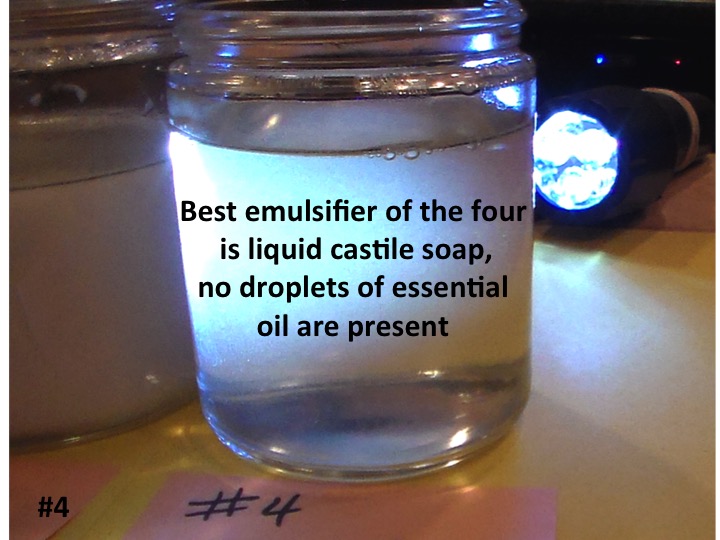
Of the 4 excipients, liquid castile soap is your best bet to fully disburse your essential oils in the bath. Some say liquid castile soap is drying….I have a solution!
I am a fan of Epsom salts for their muscle relaxing properties (magnesium), and carrier oil for softening the skin, so here is a blend I typically use for myself:
In a container I mix well:
1 cup Epsom salts
1 tbsp skin nourishing carrier oil
1 tbsp Dr. Bronner’s liquid castile soap or fragrance-free shampoo (You will likely find the shampoo to be the better choice)
3-6 drops essential oil (Depending on whether you are bathing yourself or a child)
***12/1/2016 UPDATES***READ ME IN FULL
I wanted to share an important update. I have had some state that they get an unpleasant clumping effect when using castile soap. It was never clear, however, the brand that they used. Yesterday, I decided to treat myself to an aromatic bath, and used a product I had never tried before, “Aloe vera Castile shower gel”. The result? Awful clumping! Lesson learned. Make note that I have never had this result with Dr. Bronner’s brand Castile soap…..but cannot guarantee another brand will not clump. Shampoo, however, has never failed me!
This will not be a recipe that you can make ahead of time for gifting. If you want to make it, keep the dry and wet ingredients separate and sent instructions with the gift. A little more legwork, but necessary to avoid clumping and molding.
****A great option for the bath, and especially bath bombs is Natrasorb. Read about it here.
Here are a few new images from my most recent experiment (12/13/2016). I had someone suggest fractionated coconut oil dispersed well, so I added it to the mix. See images below.
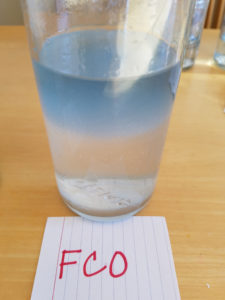
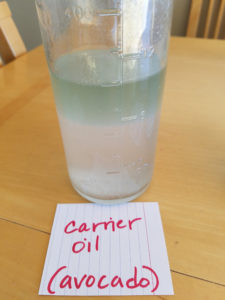
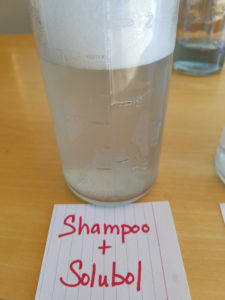
As you can see, FCO and German chamomile in warm water do not disperse. Neither does Epsom salt or any other carrier oil. The last image of shampoo/solubol is ideal. It is important to note that carrier oil is “OK” as far as it eliminates “neat” oil in the bath, and can be used in a pinch. It does not however properly disperse, so everything will sit on top of the water, no water how much you mix it. Epsom salt alone is essentially neat oil, no matter what you read on the Internet. Happy soaking!

Like so many practices in life I encourage you to become educated on the proper use of essential oils. When using them, please do so cautiously, understanding that there is often misinformation on the internet. You can be assured that I support only educated and proven resources. While essential oils should not be feared they should be respected and used properly to ensure the safety of the individuals using them.
Please note that I am not a medical practitioner. The content of this website is provided for general informational purposes only and is not intended as, nor should it be considered a substitute for, professional medical advice. Do not use the information on this website for diagnosing or treating any medical or health condition. If you have or suspect you have a medical problem, promptly contact your professional healthcare provider. By using this website, you assume full responsibility and liability for your own actions.
Witch Hazel (Hamamelis virginiana)-Uses and Limitations
Do Epsom Salts Really Work?













